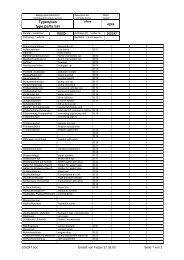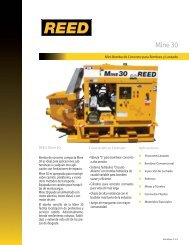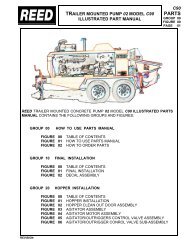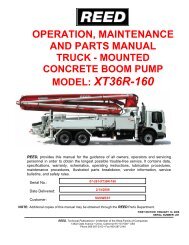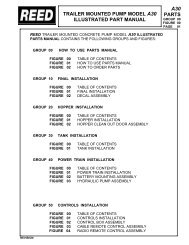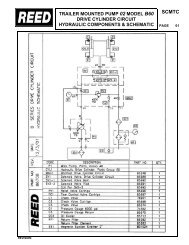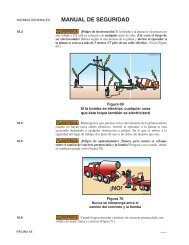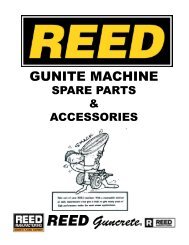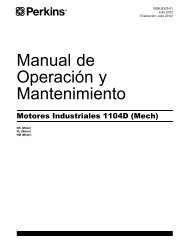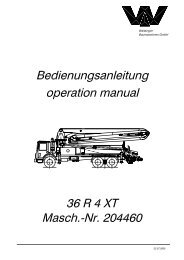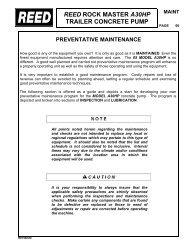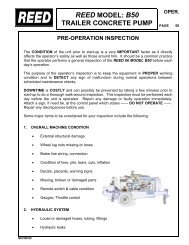Perkins Motor Operation and Maintenance Manual (English) - REED
Perkins Motor Operation and Maintenance Manual (English) - REED
Perkins Motor Operation and Maintenance Manual (English) - REED
Create successful ePaper yourself
Turn your PDF publications into a flip-book with our unique Google optimized e-Paper software.
SEBU8325-01 11<br />
Safety Section<br />
Engine Stopping<br />
If a warning tag is attached to the engine start switch<br />
or to the controls, DO NOT start the engine or move<br />
the controls. Consult with the person that attached<br />
the warning tag before the engine is started.<br />
All protective guards <strong>and</strong> all protective covers must<br />
be installed if the engine must be started in order<br />
to perform service procedures. To help prevent an<br />
accident that is caused by parts in rotation, work<br />
around the parts carefully.<br />
Start the engine from the operator's compartment or<br />
from the engine start switch.<br />
Always start the engine according to the procedure<br />
that is described in the <strong>Operation</strong> <strong>and</strong> <strong>Maintenance</strong><br />
<strong>Manual</strong>, “Engine Starting” topic in the <strong>Operation</strong><br />
Section. Knowing the correct procedure will help to<br />
prevent major damage to the engine components.<br />
Knowing the procedure will also help to prevent<br />
personal injury.<br />
To ensure that the jacket water heater (if equipped)<br />
<strong>and</strong>/or the lube oil heater (if equipped) is working<br />
correctly, check the water temperature gauge <strong>and</strong> the<br />
oil temperature gauge during the heater operation.<br />
Engine exhaust contains products of combustion<br />
which can be harmful to your health. Always start the<br />
engine <strong>and</strong> operate the engine in a well ventilated<br />
area. If the engine is started in an enclosed area,<br />
vent the engine exhaust to the outside.<br />
Note: The engine is equipped with an automatic<br />
device for cold starting for normal conditions of<br />
operation. If the engine will be operated in very cold<br />
conditions, then an extra cold starting aid may be<br />
required. Normally, the engine will be equipped with<br />
the correct type of starting aid for your region of<br />
operation.<br />
The engines are equipped with a glow plug starting<br />
aid in each individual cylinder that heats the intake<br />
air in order to improve starting.<br />
Engine Stopping<br />
i02678838<br />
Stop the engine according to the procedure in<br />
the <strong>Operation</strong> <strong>and</strong> <strong>Maintenance</strong> <strong>Manual</strong>, “Engine<br />
Stopping (<strong>Operation</strong> Section)” in order to avoid<br />
overheating of the engine <strong>and</strong> accelerated wear of<br />
the engine components.<br />
Use the Emergency Stop Button (if equipped) ONLY<br />
in an emergency situation. Do not use the Emergency<br />
Stop Button for normal engine stopping. After an<br />
emergency stop, DO NOT start the engine until the<br />
problem that caused the emergency stop has been<br />
corrected.<br />
Stop the engine if an overspeed condition occurs<br />
during the initial start-up of a new engine or an engine<br />
that has been overhauled. This may be accomplished<br />
by shutting off the fuel supply to the engine <strong>and</strong>/or<br />
shutting off the air supply to the engine.<br />
Electrical System<br />
i02176668<br />
Never disconnect any charging unit circuit or battery<br />
circuit cable from the battery when the charging unit<br />
is operating. A spark can cause the combustible<br />
gases that are produced by some batteries to ignite.<br />
To help prevent sparks from igniting combustible<br />
gases that are produced by some batteries, the<br />
negative “−” jump start cable should be connected<br />
last from the external power source to the negative<br />
“−” terminal of the starting motor. If the starting motor<br />
is not equipped with a negative “−” terminal, connect<br />
the jump start cable to the engine block.<br />
Check the electrical wires daily for wires that are<br />
loose or frayed. Tighten all loose electrical wires<br />
before the engine is started. Repair all frayed<br />
electrical wires before the engine is started. See<br />
the <strong>Operation</strong> <strong>and</strong> <strong>Maintenance</strong> <strong>Manual</strong> for specific<br />
starting instructions.<br />
Grounding Practices<br />
Correct grounding for the engine electrical system<br />
is necessary for optimum engine performance<br />
<strong>and</strong> reliability. Incorrect grounding will result in<br />
uncontrolled electrical circuit paths <strong>and</strong> in unreliable<br />
electrical circuit paths.<br />
Uncontrolled electrical circuit paths can result in<br />
damage to main bearings, to crankshaft bearing<br />
journal surfaces, <strong>and</strong> to aluminum components.<br />
Engines that are installed without engine-to-frame<br />
ground straps can be damaged by electrical<br />
discharge.<br />
To ensure that the engine <strong>and</strong> the engine electrical<br />
systems function correctly, an engine-to-frame<br />
ground strap with a direct path to the battery must be<br />
used. This path may be provided by way of a direct<br />
engine ground to the frame.



